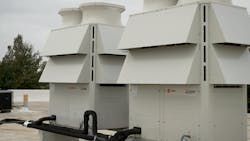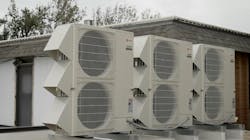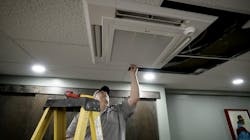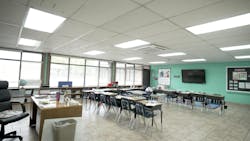Comfort might not be a top priority for most school administrators. But what if I told you that campus comfort levels have been linked to test scores?
Results from a Harvard study showed that students in New York were 11% more likely to fail a Regents exam on days when the temperature reached 90 degrees compared with 70-degree days.
Last year’s heat wave tested many school systems. In August, USA Today reported districts in Illinois, Indiana, Iowa, Missouri, Ohio, Wisconsin and other states were forced to alter schedules in response to excessive heat.
Aging infrastructure is a major challenge for many schools around the nation. A 2020 report from the U.S. Government Accountability Office found that more than 36,000 schools needed an HVAC update or replacement. Even schools that are not in the midst of an HVAC emergency may struggle to keep students and staff comfortable because of the limitations of outdated HVAC technology.
School boards and administrators should consider investing in enhanced solutions to optimize comfort and operational efficiency. In doing so, students and staff are more likely to be comfortable inside school’s walls, whether it’s 90 degrees or 5 below outside.
Variable Refrigerant Flow (VRF) offers schools a way to boost comfort and potentially cut down on annual energy costs.
VRF 101: New technology for old buildings
When teachers and students are uncomfortably hot or cold, teaching and learning become more difficult. Many school buildings have older-style systems that control all rooms from one location, leaving some spaces sweltering and others unpleasantly cold. A more effective HVAC solution enables each room to be comfortably heated or cooled to match specific usage requirements, capacity, and occupants’ preferences. VRF zoning systems make it possible to heat certain zones while simultaneously cooling others.
VRF zoning solutions are a good fit for K-12 schools and higher education campuses. VRF systems use a precise amount of energy to keep each zone at the desired temperature. Compared with conventional HVAC systems, VRF installation may be less invasive and eliminate the need to remove walls or build furr downs, which can be a dealbreaker in some older buildings.
VRF works by moving conditioned refrigerant through small-diameter piping from the outdoor unit to each zone. VRF heat recovery systems use condensing and evaporation coils to process heat energy absorbed from either outdoor or indoor air, depending on the cooling or heating needed. Added efficiency occurs when indoor zones share heat energy and bypass the outdoor unit where most of the electrical power is consumed.
Systems that can provide simultaneous heating and cooling take advantage of cooling-dominated spaces such as labs and cafeterias and share excess heat to benefit areas that may require more heating, such as classrooms and offices.
Most conventional HVAC systems use a single-stage, on-or-off compressor; VRF systems use a variable-speed, highly efficient inverter-modulating compressor that enables the system to dynamically vary the capacity needed at a given moment. This technology provides the precise amount of energy required to provide maximum comfort. The system can maintain temperatures on extremely hot or cold days and provide significant energy savings the remainder of the year.
More efficiency, less cost
VRF zoning systems perform at significantly higher efficiency than conventional HVAC systems, empowering schools to save money on energy bills.
For example, in a classroom with many windows occupied by 30 children, the system needs to be able to condition the space on a hot, sunny day. Conversely, a school will want to save energy if it is a cloudy day that is more moderate or if only 20 students are occupying the space.
A VRF system can sense a space's reduced capacity needs and automatically adjust. Whether it’s cloudier than expected or half of a class is out with the flu, the system can make the appropriate adjustments to optimize comfort while balancing energy usage. By using sensing technology for temperature, humidity, and occupancy, schools benefit from lower energy consumption, potentially decreased energy bills and a reduced carbon footprint.
Funding VRF Upgrades
For capital improvement, K-12 school districts typically rely on bonds, whether to build schools or retrofit existing faiclities with modern HVAC solutions. However, when voters reject a bond request, districts need to get creative to attain funding.
Funding for HVAC system upgrades may be available, but school districts don’t always know where to find it. Architecture firms and HVAC manufacturers can help guide them toward financing options to help them secure funding for upgrading HVAC systems. This includes ensuring administrators and boards of directors understand the benefits of funding methods such as:
- Revolving loan programs, a form of credit and flexible financing tool allowing a borrower to withdraw, repay and withdraw again.
- Performance contracting, a tool used to reduce costs by shifting the responsibility of the contract from the buyer to the supplier and specifying deliverables, performance monitoring and the management process.
- Grants like the U.S. Department of Energy’s Renew America’s Schools grant program provide funding to reduce environmental impact by investing in items such as energy-efficient HVAC systems and lighting
Building or retrofitting educational facilities with the VRF zoning solutions can stimulate better student and teacher engagement by providing more comfortable environments and reducing energy use.
A quieter place
A 50-year-old boiler system tasked with heating and cooling St. James the Greater Catholic School in Oklahoma City had a number of problems. System failures often forced occupants to wear coats indoors on chilly days. Students and staff often complained about loud, distracting noises from the system. The boiler also ran up expenses with high utility bills and expensive maintenance costs.
The school dealt with those challenges by installing a VRF system. The school gained better control of comfort levels in each classroom, reduced noise, increased space, and lowered utility bills. Most important, staff at St. James believe the improved conditions have inspired an increase in student performance.
The right HVAC upgrade can improve comfort and efficiency while helping to provide an environment that enables students, staff and faculty to thrive. VRF technology gives schools a dynamic option that can help optimize comfort in a variety of settings. Whether designing a new campus or updating an older school building, decision makers should strongly consider installing VRF equipment.
Susan Pickett is Senior Director of Strategic Development at Mitsubishi Electric Trane HVAC US.
About the Author
Susan Pickett
Susan Pickett is Senior Director of Strategic Development at Mitsubishi Electric Trane HVAC US.



